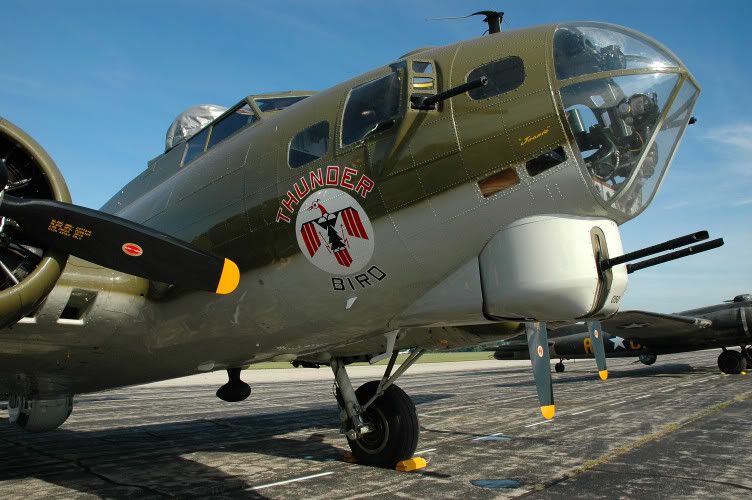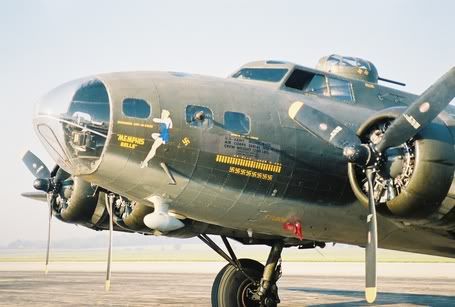B-17 F/G structural question
Wed Nov 15, 2006 3:25 pm
For those B-17 experts out there... I know that the addition of the nose turret is one of the most obvious identifiers in trying to recognize an F from a G. Structurally, is there any major difference in the fuselage? Were there different gun placements, lengths, etc? I know that the Swoose was a hodge-podge of B-17D and E parts. Could you interchange most F and G parts, especially in terms of the major structural components (wings, forward fuselage, rear fuselage, etc)?
Just curious, looking to draw on the expertise out there.
kevin
Just curious, looking to draw on the expertise out there.
kevin
Wed Nov 15, 2006 3:44 pm
F-models had side gunners directly across from each other, where the Gs had waist gunners staggered slightly to give them more room to operate the weapons.
This change and the chin turret are the main differences that I am aware of. There were many MANY running changes on the production line for both (and all the other) variants.
This change and the chin turret are the main differences that I am aware of. There were many MANY running changes on the production line for both (and all the other) variants.
Wed Nov 15, 2006 4:07 pm
The "G" was also the first of the models to have enclosed waist gun windows. Also on the "F" model, the ADF "football" antenna was located forward of the front crew hatch..and the "G" is located aft of the hatch. The cheek guns were also different.


Although this B-17F is actually a G, made into an F.


Although this B-17F is actually a G, made into an F.
Wed Nov 15, 2006 10:39 pm
The most visible differences between the F and G was armament. The chin being the most distinctive feature followed by the Cheyenne tail turret. I met the Lockheed engineer who worked on the devopment of the original chin turret installation for the 17 when I was flying Liberty Belle at Clark County airport in Indiana a couple of months ago. He was 90 yrs. young and still flew an airplane he owned.
The staggered waist guns, having permanently closed one piece windows and K-5 gun mounts on the lower sill, did not exist on early G models. They did not appear in production until the -50 at Boeing and -25 at Douglas.
The radio compartment 50 cal. was deemed ineffective and removed starting with the -75 at Douglas, -85 at Lockheed and the -105 at Boeing.
The Cheyenne tail, which had wider firing angles, and more room, was developed by United Airlines' modification center in WY., and sported a reflector, instead of a ring and bead sight.
The G had enough mods to make it 4000lbs. heavier and 10mph slower.
The Tokyo tanks also were developed for the G. These provided an extra 540 gal./side when utilized.
Anyway, it can be said that the only thing that didn't change in the 17's 10yr. span was its wing!
The staggered waist guns, having permanently closed one piece windows and K-5 gun mounts on the lower sill, did not exist on early G models. They did not appear in production until the -50 at Boeing and -25 at Douglas.
The radio compartment 50 cal. was deemed ineffective and removed starting with the -75 at Douglas, -85 at Lockheed and the -105 at Boeing.
The Cheyenne tail, which had wider firing angles, and more room, was developed by United Airlines' modification center in WY., and sported a reflector, instead of a ring and bead sight.
The G had enough mods to make it 4000lbs. heavier and 10mph slower.
The Tokyo tanks also were developed for the G. These provided an extra 540 gal./side when utilized.
Anyway, it can be said that the only thing that didn't change in the 17's 10yr. span was its wing!
Thu Nov 16, 2006 10:49 pm
Also if you look at the top turret on the F you will see that it does not see stick up as far as the turret on the G. From what I have been told the original turret was more aerodynamic, but was cramped and had poor visibility as a result, hence the larger turret on teh G.
I wonder if this was true for all f and g's, or if varied depending on different sub manufactures of the turrets.
Steve S
I wonder if this was true for all f and g's, or if varied depending on different sub manufactures of the turrets.
Steve S
Fri Nov 17, 2006 8:00 am
the nose glass on thunderbird is quite different from the usual one piece glass on a lot of g models. anybody got the how and the why on this one??
Fri Nov 17, 2006 10:19 am
I think Thunderbird's nose cone was specifically made for it's high altitude photographic/mapping work with Institute Geographique National . That would explain the smaller fabricated windows in the nose as well. Not quite sure why they never changed it to a more authentic piece. It definitely differentiates itself from the rest of the B-17 pack.
Fri Nov 17, 2006 1:37 pm
FlyingFortB17 wrote:I think Thunderbird's nose cone was specifically made for it's high altitude photographic/mapping work with Institute Geographique National . That would explain the smaller fabricated windows in the nose as well.
You are correct! Hopefully that will bechanged sometime in the future.